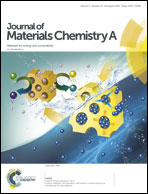Molecular self-assembly of a nanorod N-Li4Ti5O12/TiO2/C anode for superior lithium ion storage†
Abstract
Spinel lithium titanate (Li4Ti5O12, LTO) is one of the most appealing anode materials for lithium-ion batteries (LIBs) due to its long cycle life and high safety performance. However, its low intrinsic electronic conductivity limits its high rate capability. Herein, we develop a novel one-pot in situ molecular self-assembly approach to prepare a dual N- and anatase-TiO2- modified Li4Ti5O12/C nanorod material (NT-LTO/C). Polypyrrole (PPy), as a pivotal carbon and nitrogen source, is introduced to confine the morphology and particle size of the NT-LTO/C anode. Due to the synergistic effects of the multilevel particle structure, uniform carbon coating, N doping, anatase TiO2 pseudopotential effect and such benefits, the NT-LTO/C electrode delivers a high reversible capacity of 196.3 mA h g−1 at 0.5C, and it maintains 105.5 mA h g−1 even at an ultrahigh rate of 100C with progressive cycling of more than 3000 cycles. In addition, the three electrode pouch full-cell shows much smaller polarization than the pristine one. This novel and facile molecular self-assembly method has broad advanced functional material applications including for ceramics, polymer/carbon-based metal alloys and inorganic non-metallic materials.



 Please wait while we load your content...
Please wait while we load your content...